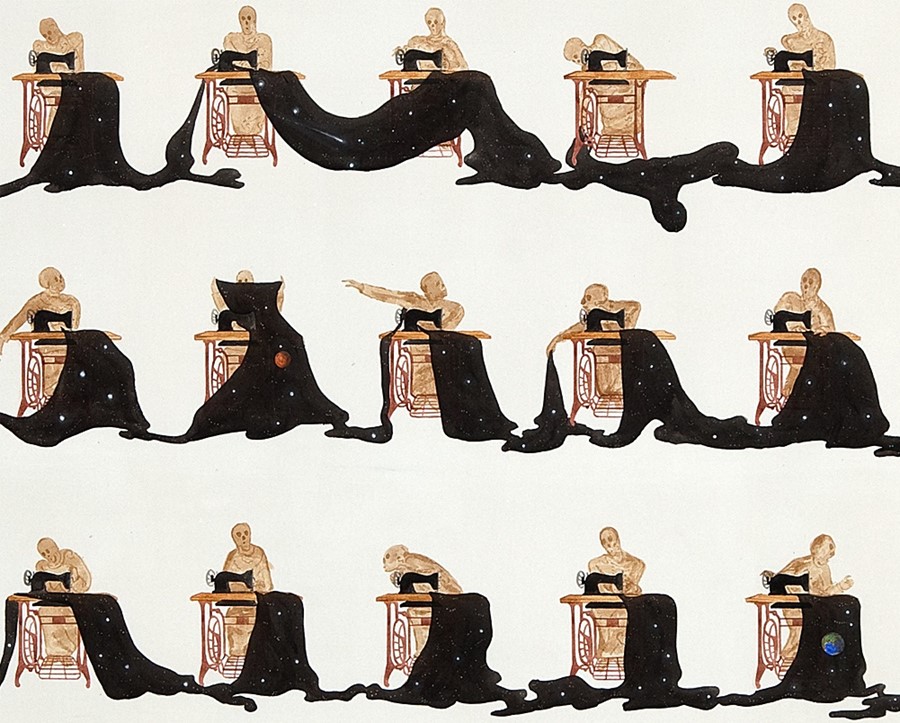NS Harsha was born in 1969. He lives and works in Mysore, India. Represented in London by Victoria Miro Gallery, he is famed for his ability to paint with the greatest preciseness the portrait of numerous human beings.
Organised around a regular pattern: in this column each interviewee picks the picture that illustrates their interview, answers six questions that are the same for all contributors and then two more that are designed specifically for them.
NS Harsha was born in 1969. He lives and works in Mysore, India. Represented in London by Victoria Miro Gallery, he is famed for his ability to paint with the greatest preciseness the portrait of numerous human beings. His art has been shown in numerous prestigious venues, such as Indian Highway at the Serpentine Gallery and the Astrup Fearnley in Oslo, and the 26th Sao Paulo Biennale. After a solo show at Maison Hermès in Tokyo in 2008, he has been invited to design a scarf for the French brand.
1.How would you connect fashion to elegance?
Can I say elegance 'inspires' fashion? Elegance celebrates timelessness while in contrast fashion celebrates a particular moment of human history. Elegance creates union between material and body, while fashion makes ‘materials’ work around the body.
2. What is the role of history and art history in your conception of fashion?
A dialogue is always on. Here in India we have a very strong relationship between history and clothing. For example, Gandhi’s Khadi movement still has a significant role to play when it comes to contemporary fashion. People try to dodge it or to accommodate it but they are still having a dialogue with the movement either way. The more fashion aims to invent, the more it needs to be informed about the past I guess? So, for me, Fashion and history move hand in hand...
3. Would you describe fashion as a language and a discourse, as Barthes did it?
Of course fashion is a language! I am not aware of Barthes' text. But yes, indeed, fashion/clothing is a strong platform to express/communicate one’s beliefs, political position and so on.... I feel a visual dialogue starts between two people before the verbal exchanges. It is a treat when we experience a union of clothing, speech and expressions in an individual, one could term it as grace or elegance. In contrast, many times we come across fashion that is completely misunderstood which results in the projection of ignorance.
4. The word "intellectual" was coined in a time of great political distress. Does fashion have a political role? And in which way?
As mentioned above there may not be a better example than Gandhi’s Khadi Movement which brings clothing and politics to the same platform. Fashion can be a strong tool to express one’s communal position and attract like minded people and at the same time keep off certain other individuals. ‘Statement’ is a commonly used word in the fashion community, where the word has a political quality embedded into it.
5. How would you relate the concept of fashion to the one of style ?
Style can become very repetitive or stagnant. We can observe some individuals/societies live with a certain style all their life, this I believe works against the core of the human spirit. But fashion has room to play, to extend and to contract; to create dialogues with the changing times.
6. What does fashion have to do with intellectuality?
A good mix of inner lightness and curiosity can bond fashion and intellect very well. Often we experience intellect overpowering fashion, but then we may create an imbalance in our ‘presence’. We are playful and vibrant in our thoughts but dry and vague in our physical outlook. Often this is also the case in religious beliefs. I should confess I lived my life almost like wearing an opaque Elizabethan collar. So not really suited to elaborate on this question.
7. You designed a scarf for Hermès. How does that experience relate to your activity as an artist?
It was an interesting collaboration. Sitting in my hometown, Mysore, I didn’t know what Hermès was in the beginning. My ignorance in world fashion. Craftsmanship and perfection inspired me in Hermès. Which are rare words used in context of art. So making the scarf was a purely an experiment and an extension of my paintings. As the title of my scarf suggests, it was an experience filled with ‘Colour Masala’!
8. In your paintings, people are represented with extreme precision, including their clothes ; what part do you give to painting clothes in your artistic world ?
Clothing has played a very important role in my works for past 15 years. I have enjoyed playing (teasing) with the significance and symbols emitted out of clothing pattern. As mentioned before a visual dialogue gets triggered when we see an individual dressed in a particular manner. I exaggerate these situations by bringing a few others into the picture plane so that they may compliment, challenge and contrast creating a multitude of dialogs between images. At the moment I am experimenting with nudity which is an interesting situation in conjunction to fashion. But my journey is more towards the idea of ‘Nirvana’.
In two weeks Donatien will be interviewing the graffiti artist and impresario André.
